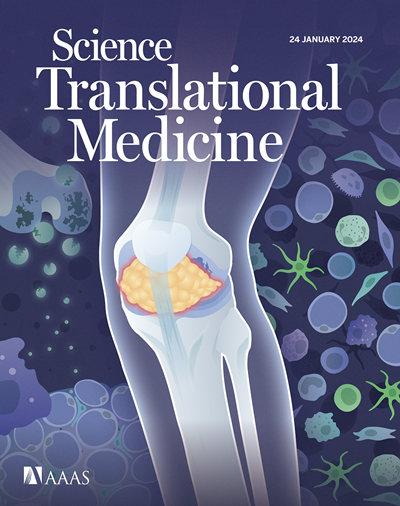Single-cell transcriptomic and proteomic analysis of Parkinson’s disease brains
IF 15.8
1区 医学
Q1 CELL BIOLOGY
引用次数: 0
Abstract
Parkinson’s disease (PD) is a prevalent neurodegenerative disorder, and recent evidence suggests that pathogenesis may be in part mediated by inflammatory processes, the molecular and cellular architectures of which are largely unknown. To identify and characterize selectively vulnerable brain cell populations in PD, we performed single-nucleus transcriptomics and unbiased proteomics to profile the prefrontal cortex from postmortem human brains of six individuals with late-stage PD and six age-matched controls. Analysis of nearly 80,000 nuclei led to the identification of eight major brain cell types, including elevated brain-resident T cells in PD, each with distinct transcriptional changes in agreement with the known genetics of PD. By analyzing Lewy body pathology in the same postmortem brain tissues, we found that α-synuclein pathology was inversely correlated with chaperone expression in excitatory neurons. Examining cell-cell interactions, we found a selective abatement of neuron-astrocyte interactions and enhanced neuroinflammation. Proteomic analyses of the same brains identified synaptic proteins in the prefrontal cortex that were preferentially down-regulated in PD. By comparing this single-cell PD dataset with a published analysis of similar brain regions in Alzheimer’s disease (AD), we found no common differentially expressed genes in neurons but identified many shared differentially expressed genes in glial cells, suggesting that the disease etiologies, especially in the context of neuronal vulnerability, in PD and AD are likely distinct.
帕金森病大脑单细胞转录组和蛋白质组分析。
帕金森病(Parkinson's disease,PD)是一种常见的神经退行性疾病,最近的证据表明,发病机制可能部分由炎症过程介导,而炎症过程的分子和细胞结构在很大程度上尚属未知。为了鉴定和描述帕金森病中选择性脆弱的脑细胞群,我们对六名晚期帕金森病患者和六名年龄匹配的对照组患者的死后大脑前额叶皮层进行了单核转录组学和无偏蛋白质组学分析。通过对近80,000个细胞核的分析,确定了八种主要的脑细胞类型,包括帕金森病患者脑驻留T细胞的升高,每种类型都有不同的转录变化,与已知的帕金森病遗传学一致。通过分析相同死后脑组织中路易体的病理变化,我们发现α-突触核蛋白病理变化与兴奋性神经元中伴侣蛋白的表达成反比。在研究细胞-细胞间的相互作用时,我们发现神经元-胃囊细胞间的相互作用选择性减弱,神经炎症增强。对相同大脑的蛋白质组分析发现,前额叶皮质中的突触蛋白在帕金森氏症中优先下调。通过将这一PD单细胞数据集与已发表的对阿尔茨海默病(AD)类似脑区的分析进行比较,我们发现神经元中没有共同的差异表达基因,但在胶质细胞中发现了许多共同的差异表达基因,这表明PD和AD的病因,尤其是神经元脆弱性方面的病因可能是不同的。
本文章由计算机程序翻译,如有差异,请以英文原文为准。
求助全文
约1分钟内获得全文
求助全文
来源期刊

Science Translational Medicine
CELL BIOLOGY-MEDICINE, RESEARCH & EXPERIMENTAL
CiteScore
26.70
自引率
1.20%
发文量
309
审稿时长
1.7 months
期刊介绍:
Science Translational Medicine is an online journal that focuses on publishing research at the intersection of science, engineering, and medicine. The goal of the journal is to promote human health by providing a platform for researchers from various disciplines to communicate their latest advancements in biomedical, translational, and clinical research.
The journal aims to address the slow translation of scientific knowledge into effective treatments and health measures. It publishes articles that fill the knowledge gaps between preclinical research and medical applications, with a focus on accelerating the translation of knowledge into new ways of preventing, diagnosing, and treating human diseases.
The scope of Science Translational Medicine includes various areas such as cardiovascular disease, immunology/vaccines, metabolism/diabetes/obesity, neuroscience/neurology/psychiatry, cancer, infectious diseases, policy, behavior, bioengineering, chemical genomics/drug discovery, imaging, applied physical sciences, medical nanotechnology, drug delivery, biomarkers, gene therapy/regenerative medicine, toxicology and pharmacokinetics, data mining, cell culture, animal and human studies, medical informatics, and other interdisciplinary approaches to medicine.
The target audience of the journal includes researchers and management in academia, government, and the biotechnology and pharmaceutical industries. It is also relevant to physician scientists, regulators, policy makers, investors, business developers, and funding agencies.
 求助内容:
求助内容: 应助结果提醒方式:
应助结果提醒方式:


